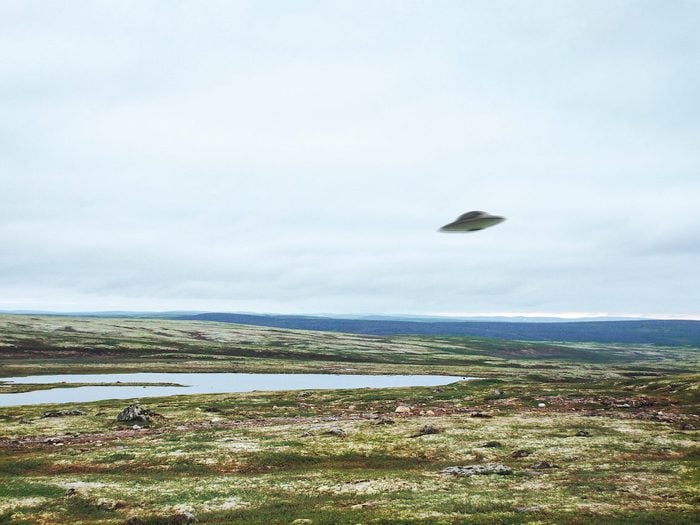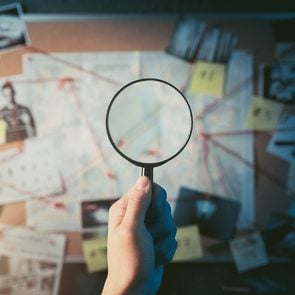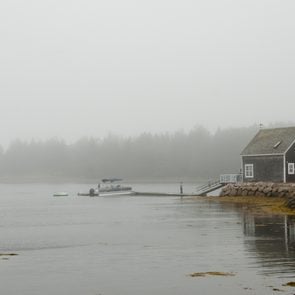Meet the Canadian UFO Hunters Trying to Prove We’re Not Alone

Jason Guillemette’s memory of the event is hazy around the edges, like a half-forgotten dream. He was 13 at the time, living with his family in the remote Quebec mining town of Cadillac. It was September, around 9 p.m. He remembers being perched on the handlebars of a bicycle, like E.T., while his twin brother pedalled. They were on their way home from a friend’s house when they were suddenly bathed in an intense red light.
“It came from directly above us,” says Guillemette, now 40, fair-haired, bearded and living in Chilliwack, B.C. “My brother stopped the bike right away, and I just remember looking up, because I thought a street-light transformer had blown.” But it wasn’t anything that could be so easily explained.
Hovering some 20 or 30 metres above them, he says, was a school bus-sized spacecraft. It was oblong in shape, with an underside that glowed like an overheated stove element. The ship moved silently, casting a crimson light on the street below. The two brothers stood speechless as it slipped past them and drifted over a row of houses on the horizon. Then it was gone.
In the decades since, Guillemette and his brother have told countless people this story. Some believed them, but most didn’t. Skepticism of aliens runs deep, after all, and for good reason—despite centuries of supposed sightings, there’s never been any conclusive proof that they exist.
But for Guillemette, the moment was life-altering. He had seen something that no amount of eye rolling was going to change. “There’s not a person on this planet who could tell me that I didn’t see what I saw,” he told me. It was the start of what he describes as a lifelong obsession with UFOs: reading books, watching documentaries and poring over obscure websites and online forums. Eventually he found his way into Canada’s ufology community.
Ufologists (pronounced “yew-fol-o-gists”) are people who study unidentified flying objects. There are an estimated 10,000 amateur ufologists in North America today, and interest is growing.
For decades, ufologists like Guillemette have operated on the fringes of science and academia. They gather in virtual meet-ups and swap videos of strange lights in the night sky on Facebook pages. They carry out their own amateur research. The truth is out there, ufologists insist, if only we’d bother to look.
Canadian UFO sightings
Guillemette’s experience might seem a bit far-fetched. But UFO sightings are surprisingly common. About 10 per cent of Canadians claim to have seen one. On average, there are three Canadian UFO sightings reported every day, according to the Winnipeg organization Ufology Research. The group counted 1,243 sightings in 2020, up nearly 50 per cent from the year before.
“It may be because during the pandemic, people have had more time to look up at the sky,” says Chris Rutkowski, who founded Ufology Research in 1979.
Rutkowski, white haired and bespectacled, runs his volunteer-based research organization out of a home office cluttered with bookshelves, E.T. figurines and Marvin the Martian dolls. Rutkowski has never seen a UFO himself, he told me. He started collecting stories of UFO sightings as an undergraduate student in astronomy at the University of Manitoba back in the 1970s. He spoke with people from all walks of life—from Prairie farmers to airline pilots to radar operators. “It became obvious that there was a very fascinating phenomenon that deserved a little more scientific study,” he says.
In its reports, Ufology Research breaks down cases by the number of witnesses, the colour and shape of the UFO (everything from orbs to boomerangs), the level of “strangeness” (an encounter with “grey-skinned aliens” would be considered highly strange, whereas a single flashing light in the sky would not), the reliability of the sighting (based on the number of witnesses and how well-documented it was) and its duration. In 2020, a typical sighting lasted more than 20 minutes and had between one and two witnesses.
The majority of these events can be explained as aircraft, satellites, drones or simply lens flare on a camera. Still, roughly five per cent of all UFO reports Rutkowski receives remain unresolved. It’s these ones—the ones that can’t be easily pinned down—that get ufologists excited.
The proof
But how does a person prove that UFOs actually exist? For ufologists, that’s always been the conundrum. The truth might be out there—but it’s frustratingly elusive. UFO sightings are usually fleeting. Memories of the events are often shaky, the photographs blurry. Details become unreliable.
Guillemette volunteers as a field investigator with the Mutual UFO Network (MUFON), a U.S. organization with more than 4,000 members. He estimates he spends upwards of 15 hours per week investigating sightings, reading ufology news and producing a monthly podcast on the subject. He does all this with a family (including two kids) and a day job selling insurance to juggle.
“When I first started talking about ufology with my wife, she wasn’t too sure what the deal was,” he admits. But she’s been supportive, he says, sometimes even joining him to scan the night sky outside their home.
Guillemette’s investigations usually start in one of two ways: someone sends a request to the MUFON website or he’s contacted through one of several ufology-focused Facebook groups, such as UFO BC.
Most of the time, he’s able to find a non-UFO explanation. He often sends videos to other volunteers at MUFON who specialize in analyzing computer images. He refers to websites that track the flight patterns of satellites, planes and the International Space Station—the usual suspects when it comes to UFO sightings, he says. Guillemette described a recent case in which a couple reported seeing strange lights hovering above a nearby lake. The lights circled above the lake and then dropped down into the water, only to rise up a moment later and zip away. It turned out to be a plane, he says—filling up with water to fight a nearby forest fire.
But like sightings submitted to Ufology Research, there are some that defy easy explanation. Recently, there have been multiple reports in the Fraser Valley of a triangular-shaped UFO with three lights on its underside, Guillemette says. For cases like this, Guillemette does what he calls a “night watch.” He drags his equipment—a camera, tripod and binoculars—to where the sighting occurred and hunkers down for the evening in hopes of catching a glimpse of something strange.
To date, Guillemette hasn’t tracked down any hard evidence of extraterrestrial life. The mysterious triangular lights continue to elude him—popping up here and there, like a never-ending game of whack-a-mole.
A history of Canadian UFO sightings
People have been seeing mysterious things in the sky for centuries, and likely earlier. There are plenty of cosmic-encounter tales from Indigenous cultures. Take the “Skyman” or “Man from the Sky” legend from the Anishinabe people of central Ontario, a version of which was recorded in 1917 by ethnologist Colonel G.E. Laidlaw. Five hundred years ago, a pair of Ojibwe men stumbled upon a stranger sitting in a grass field. This figure, described as “clean and shining bright,” told the men, “I don’t belong to this land. I dropped down from above, yesterday, so I am here now.” The men invited the Skyman back to their village, where he stayed but was visibly restless. One afternoon, Skyman looked up and said, “It is coming.” The villagers craned their necks and saw something that looked like a bright shining star streak down from the heavens and hover near the ground. Skyman entered the shining star and disappeared from view. The ship then shot back into the sky and faded away.
The first UFO sighting of the modern era is often credited to an American pilot named Kenneth Arnold. On June 24, 1947, Arnold was flying his propeller plane from Yakima to Chehalis, Washington. Midway through his trip, he claimed to have seen nine flying objects lifting off the ground near Mount Rainier and whooshing past him at speeds of more than 1,600 kilometres an hour. They spun like “saucers,” he told newspaper reporters the following day.
After Arnold, Americans began spotting all sorts of unidentified objects overhead. At the same time, the U.S. Air Force started tracking UFO reports through what was called Project Blue Book. The research program ran for nearly 20 years and recorded more than 12,000 sightings. Project Blue Book was shuttered after the military concluded it had found no evidence of UFOs (something ufologists dispute to this day).
The Canadian government launched a similar UFO research program called Project Magnet in 1950. A UFO observatory was even built in Shirleys Bay, just outside Ottawa. The four-metre-square shed housed instruments including a gamma-ray counter, a magnetometer, a radio receiver and a cluster of antennae. The program was closed just a few years later, with the government concluding that UFOs were “not amenable to scientific inquiry.”
As governments scaled back on research, public interest in UFOs seemed to only grow stronger. In the Nova Scotia fishing village of Shag Harbour, multiple residents reported seeing a glowing object flying over the harbour and then crashing into the water on the night of October 4, 1967. Witnesses reported hearing a whistling sound “like a bomb,” then a “whoosh,” and finally a loud bang. The object was never officially identified.
That same year, in Falcon Lake, Manitoba, mechanic Stefan Michalak claimed to have seen two cigar-shaped glowing ships while on a prospecting trip in the woods. According to Michalak’s account, one of the ships landed, but when he tried to approach it he was badly burned. He went to a nearby hospital with strange grid-like welts across his body. For weeks afterward, Michalak suffered from headaches, blackouts and weight loss.
Governments and universities have started to take the possibility that life exists on other planets more seriously. The field of research known as the Search for Extraterrestrial Intelligence, or SETI, has gained acceptance in academia. SETI research involves pointing giant radio telescopes at distant corners of the galaxy and listening for signals that could be from intelligent life. SETI research has recently gained more steam, fuelled by private donors and the discovery of thousands of Earth-like planets elsewhere in the galaxy. One of the world’s largest telescopes is near Penticton, B.C. In 2019, scientists there made headlines when they recorded mysterious repeating signals from a far-off solar system that remain unexplained.
The quest for answers
One day, will we look back and be amazed that we once thought we were alone in the universe? Maybe. It wasn’t that long ago that scientists believed aliens were living on Mars. In the 19th century, an Italian astronomer named Giovanni Schiaparelli swore that he saw canals on the surface of the red planet. Clearly they’d been dug by someone, he argued (in fact, they were simply features of the planet’s topography). Not long before that, we believed that the entire universe revolved around the Earth. All this is to say that science is forever changing. What was once heretical can eventually become an accepted truth. Or not.
It’s hard to know what to say when someone recounts a UFO sighting. It simply doesn’t jibe with our dominant worldview. Over the course of this story, I talked with three people who had seen unexplainable, mind-boggling objects in the sky. Each spoke candidly about their experience and described it with compelling certainty, even bravery. And each time, I replied with something along the lines of “wow,” which was shorthand for I’m really not sure what to say.
But in a way, I could empathize. As a kid, I had a somewhat similar experience, though it wasn’t exactly a UFO. Here’s what I remember: I was six or seven years old at the time, standing on a neighbour’s back step with a friend who lived down the street. It was early evening, and a thunderstorm had just passed. The air was heavy, the ground still wet. That’s when we saw it: a ball of fire, hovering like a comet about three metres off the ground. It was the size of a basketball and it seemed to glide through the air in a way that defied gravity, as if pulled by a string.
I don’t recall where the fireball went or who we told, if anyone. It’s a memory that’s been cut out from time. But the experience stuck with me. Years later, I pored through books at my university library and found an answer: a phenomenon known as “ball lightning.” There are numerous historic accounts of lightning balls—flying through open windows, shooting out of a fireplace, even floating down the aisle of a church—though there is still no proven scientific explanation. Still, finding a plausible answer was a relief for me.
But maybe the quest for an answer is misguided. Maybe the power of seeing something unexplainable in the sky is that it reminds us that we don’t know everything, and that mysteries still exist. In this way, ufology might be more akin to a modern religion or philosophy—one that’s rooted in the belief that we are not alone and that salvation (in the form of an alien visitor) might still be possible.
“People have a desire to believe that life is out there,” Ufology Research’s Chris Rutkowski told me. “This belief shapes our culture, it shapes our society, and it’s part of who we are. I think we’ve come to hope that there might be somebody out there wanting to communicate with us.”
I asked Jason Guillemette, the ufologist who saw the school bus-sized spacecraft as a kid, when he thought there might be hard evidence that UFOs exist. He talked about a recent news story about two U.S. Air Force pilots who recorded several interactions with what the Pentagon described as an “unidentified aerial phenomenon.” The videos show a round object that resembles a spinning top hovering and then zooming across the pilot’s screen (you can hear one of the pilots drawl “Look at that thing, dude”). According to a New York Times story, the mysterious object had no visible engine or exhaust plumes but was able to reach hypersonic speeds. The videos are worth checking out, but they’re not quite the smoking gun I was looking for.
“I mean irrefutable proof,” I said—proof that would convince even non-ufologists. “I would say definitely within the next five years,” Guillemette eventually predicted. “Five years, for sure.” He paused for a moment, then said: “I mean, hopefully.”
For more explorations into the paranormal, check out Canada’s most haunted places.
© 2021, Maisonneuve. From “I Want To Believe,” by Brad Badelt, from Maisonneuve (June 17, 2021), Maisonneuve.org






